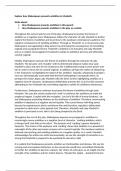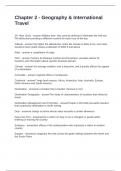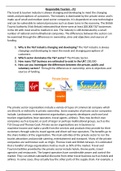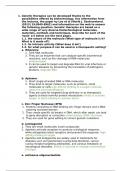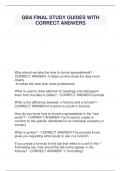Made in study year: 2024-2025
Grade 1st attempt: 8.1
,Lecture 1 (Patho)physiology of the GI tract
What are the macronutrients and what are they made of?
- Carbohydrates - made of carbon, oxygen and hydrogen
Monosaccharides
Are the carbohydrates which can not be hydrolysed to a simpler compound.
There are three different monosaccharides; glucose, galactose, fructose.
Disaccharides
Consists of two monosaccharides with glycosidic bonds (linked together by
condensation).
There are three important ones;
Maltose – 2x glucose
Lactose – 1x glucose, 1x galactose
Sucrose – 1x glucose, 1x fructose
Polysaccharides
Long chains of monosaccharide units, they are not absorbed but digested first.
The major polysaccharides are glycogen and starch.
Fiber – is not digested but bacteria break them down (some fatty acids are released
by this process).
- Fats
Saturated fats
Are always single bonded fats.
Unsaturated fats
Mono unsaturated fats – one double bond in one chain
Poly unsaturated fats – more double bonds in one chain
• Omega-3 fats (essential)
Have 2 double bonds, first double bond is on the third carbon-bond.
• Omega-6 fats (essential)
Have 3 double bonds, first double bond is on the sixth carbon-bond.
Triacylglycerol
In this way fats are found in food, triacylglycerol
is composed of glycerol and fatty acids.
- Proteins
Amino acids
Amino acids are made of; an amino group (NH2), a hydrogen, a side
chain and a acid/carboxyl group (COOH). The side chain is the most
important for the determination of the amino acid.
Different amino acids are build up to proteins (polypeptides) by peptide bonds.
Amino acids can be essential (9) or non-essential (11).
Amino acids are bonded with peptide bonds, to bind the amino acids, water is
released, this reaction is called condensation.
Their unique shapes enable them to perform actions (enzymes, transport etc.)
Hormones, enzymes and antibodies can be made out of proteins.
, Digestion, absorption and storage of the macronutrients.
- Carbohydrates
Digestion
Amylase in saliva breaks down (hydrolyses) starches into shorter polysaccharides and
into the dissacharide maltose, this process continues in the oesophagus.
The amylase is made inactive by the low pH of HCL.
Pancreatic juice contains amylase, which will break down the remaining starches into
maltose.
Additionally, in the brush border of the small intestine, enzymes are found that
further break down the disaccharides to monosaccharides.
Maltase breaks down maltose into two glucoses.
Lactase breaks down lactose into one glucose and one galactose.
Sucrase breaks down sucrose into one glucose and one fructose.
Fibers can not be digested, the are broken down by bacteria in the large intestine, in
this process, water, gas, and short-chain fatty acids are released.
Absorption of glucose/galactose
Most of the absorption of glucose takes place in the small intestine.
Glucose and galactose enter the cells by active transport, fructose is absorbed by
facilitated diffusion.
Storage
The monosaccharides are first used by organs to provide energy. If there are too
many monosaccharides, the remaining ones are stored in the liver and muscles as
glycogen. Once the liver and muscles are full, the monosaccharides are converted
and storage as fat.
- Fats
Digestion
In the mouth a small amount of triacylglycerol is broken down by the enzyme lingual
lipase, it is broken down into glycerol and 3 fatty acids. In the mouth, phospholipids,
work as emulsifiers.
Gastric lipase is produced in the stomach, it also breaks down the triacylglycerol into
glycerol and 3 fatty acids. However, emulsification here only happens because of
contraction of the stomach.
When the chyme is released into the small intestine, it needs to be emulsified before
it can be absorbed. The gall bladder secretes bile salts, which emulsify the fats in the
chyme. When long-chain fatty acids and monoglycerides are emulsified by bile, they
form micelles.
Most of the hydrolysis of triglycerides happens by pancreatic lipases.
, After bile enters the small intestine and emulsifies fat, it has two possible
destinations. Most of the bile is reabsorbed from the ileum and recycled. This is
called the enterohepatic circulation.
Some of the bile can be trapped in the large intestine and excreted.
Absorption
The absorption of long chain triglycerides (LCTs) and short/medium chain
triglycerides (S/MCTs) is different.
- S/MCTs can be absorbed directly and enter the vena portae to the liver.
- These micelles diffuse into the intestinal cells, where the monoglycerides and long-
chain fatty acids are reassembled into new triglycerides.
- Other LCTs enter via the mentioned micelles. The micelles are hydrophilic on the
outside, which means that they can fuse with the outside of the intestinal cell
membrane. After the fusion, fatty acids and glycerol are inside of the intestinal cell.
Together with cholesterol and fat soluble proteins, it becomes chylomicrons. Those
chylomicrons can go through the blood (via lymphatic vessels).
LCT are the only digested particles that don’t go via the liver at first. They move to
the heart directly via the lymphatic system.
Storage
When you eat fats, the pancreas is stimulated to secrete insulin. This insulin is
important for the uptake of fat into fat cells muscle cells and liver cells.

